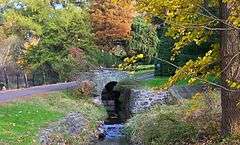Morris Arboretum
|
Compton and Bloomfield | |
|
A bridge at the Morris Arboretum | |
   | |
| Location | 100 East Northwestern Avenue, Philadelphia and Whitemarsh Township, Pennsylvania |
|---|---|
| Coordinates | 40°05′23″N 75°13′27″W / 40.08972°N 75.22417°WCoordinates: 40°05′23″N 75°13′27″W / 40.08972°N 75.22417°W |
| Area | 175 acres (71 ha) |
| Built | 1889 |
| Architect | Theophilus Parsons Chandler, Jr.; Wilson Eyre, Jr., et al. |
| Architectural style | Classical Revival, Late Gothic Revival |
| NRHP Reference # | 78002445 [1] |
| Added to NRHP | December 22, 1978 |
The Morris Arboretum of the University of Pennsylvania (37 ha / 92 acres) is the official arboretum of the Commonwealth of Pennsylvania. It is located at 100 East Northwestern Avenue, Chestnut Hill, Philadelphia, Pennsylvania. The arboretum is open daily except major holidays; an admission fee is charged.
History
The arboretum was formerly the estate of John and Lydia Morris, who purchased and landscaped much of the arboretum's current site starting from the 1880s. Morris was interested in growing plants from around the world, including those collected in China by E. H. Wilson around 1900, and many of today's specimens date to Morris' original plantings. The estate became a public arboretum in 1933.[2]
Collection
Today the arboretum contains more than 13,000 labelled plants of over 2,500 types, representing the temperate floras of North America, Asia, and Europe, with a primary focus on Asia. Significant collections include native azaleas, conifers, hollies, magnolia species, maples, roses, and witch hazels. The arboretum has identified 17 trees in its collection as outstanding specimens: Abies cephalonica, Abies holophylla, Acer buergerianum, Aesculus flava, Cedrus libani var. atlantica 'Glauca', Cercidiphyllum japonicum, Fagus engleriana, Fagus sylvatica f. pendula, Metasequoia glyptostroboides, Pinus bungeana, Platanus × acerifolia, Quercus alba, Quercus × benderi, Tsuga canadensis f. pendula, Ulmus glabra 'Horizontalis', Ulmus parvifolia, and Zelkova serrata.
Features
The arboretum is set within a fine, mature landscape, primarily designed in the English park style but with Japanese influences. It includes winding paths and streams, a swan pond, formal rose gardens, and large sweeps of azaleas, rhododendrons, and magnolias. Notable aspects of the arboretum are as follows:
.jpg)
- English Park (circa 1912) - mainly planted with species collected in China, with significant collections of maples, witch hazels, dogwoods, cherries, and stuartias.
- Fernery (1899) - an 8-sided glass house said to be the only remaining free-standing Victorian fernery in North America. Morris ordered his original ferns from London expert John Birkenhead. The collection was botanically grouped and labelled; it included 523 fern varieties and 47 Selaginella (club moss) varieties.
- Garden Railway - G scale trains and trolley cars running on 45 mm track (1¾"), and representing railroads throughout history, including freight and passenger models.
- Greenhouse - closed to the public; little now remains of Morris' original structure.
- Japanese Overlook (1912) - a hybrid of English rock garden with Japanese garden, landscaped with fudo stones, stone lanterns, and Japanese maples, conifers, and smaller acid-loving plants.
- Japanese Hill and Water Garden (1905) - Tsukiyama-niwa style garden with hills, rocks, water, trees, bridges, paths, shrines and lanterns.
- Mercury Loggia and Ravine Garden (1913) - classical loggia housing a sculpture of "Mercury at rest", with grotto and a picturesque rock garden within the valley below.
- Rose Garden (1888) - a buxus-edged rose garden in four quadrants.
- Rock Wall Garden (1924) - alpine plants on a six-foot-high wall.
- Swan Pond (1905) - a small lake created by digging and damming the East Brook.
- Compton Mansion (aka Morris House, 1887-1888, demolished 1968)
Morris Arboretum also owns Springfield Mill, which is located opposite the main entrance. The grist mill has been restored and is open to the public once a month for grinding demonstrations.
See also
References
- ↑ National Park Service (2007-01-23). "National Register Information System". National Register of Historic Places. National Park Service.
- ↑ "National Historic Landmarks & National Register of Historic Places in Pennsylvania" (Searchable database). CRGIS: Cultural Resources Geographic Information System. Note: This includes George E. Thomas (August 1978). "National Register of Historic Places Inventory Nomination Form: Compton and Bloomfield" (PDF). Retrieved 2012-05-24.
External links
| Wikimedia Commons has media related to Morris Arboretum. |
- Morris Arboretum
- Compton's listing at the Historic American Buildings Survey
- Morris Arboretum: A living collection (2000). Sculpture magazine / artdesigncafe. March 2000. Retrieved March 19, 2011.



